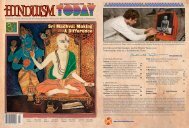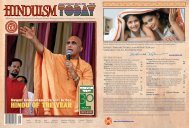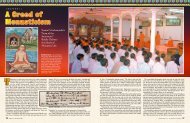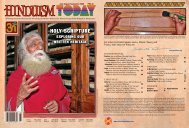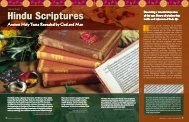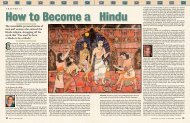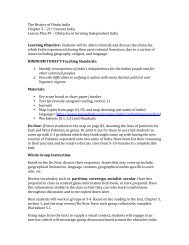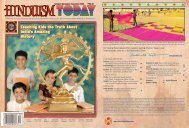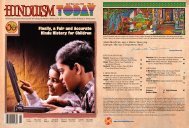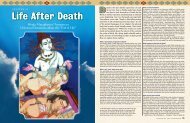Hinduism Today July 2007 - Cover, Index, Gatefold, Front Articles
Hinduism Today July 2007 - Cover, Index, Gatefold, Front Articles
Hinduism Today July 2007 - Cover, Index, Gatefold, Front Articles
Create successful ePaper yourself
Turn your PDF publications into a flip-book with our unique Google optimized e-Paper software.
all photos: prasanna kumar<br />
Life in many colors: (clockwise from far<br />
left) Paramanand Biswal carves the palm<br />
leaves to the right; village women worship<br />
on the street during the holy month of Karttika;<br />
the diligence of an apprentice; young<br />
Odissi dancers exemplify the blooming cultural<br />
life at the community theather<br />
ghul empire of India, in 1527. The complex<br />
rules demand knowledge of religion, culture<br />
and folklore. Card sets can have 46, 96, 120<br />
or 144 cards, with specific ways of playing<br />
each, and the rules can also vary depending<br />
on how many colors were used to make<br />
the card set. It is a game for the initiated<br />
and the knowledgeable, which may soon<br />
become extinct, its cards a mere relic. Only<br />
four people play it in Raghurajpur.<br />
Even though some other people, mostly elders,<br />
play it around Orissa, each village has<br />
its own variations and house rules, and the<br />
craft’s village is no exception. Like bridge or<br />
whist, all four players are necessary for each<br />
game, and if they cannot come there are no<br />
possible substitutes.<br />
Preparing the cards is a time-consuming<br />
task. Artisans such as Mukunda create a<br />
special glue made of tamarind seeds, used<br />
to harden smooth, flat cloth. Pieces are then<br />
trimmed perfectly round and pasted together<br />
to form the cards; a fine layer of liquid<br />
chalk is applied to make them white. Only<br />
then can the artist begin to paint the many<br />
traditional cards, using paints he makes<br />
himself with colorful minerals and herbs<br />
and, in the case of black, burnt lamp wicks.<br />
Each Deity has a special color that must be<br />
used in the decorations of his card, according<br />
to the traditional rules, to aid identification.<br />
Since the card sets are hand-made, they<br />
all vary slightly; and their meaning could be<br />
lost if not for this standard coloring system.<br />
Lord Rama, for example, is always painted<br />
in green against a red background.<br />
Mukunda Maharana has given to the village<br />
much of what he could share, teaching<br />
the chitrakar craft. His son, Lingaraj, carrying<br />
on the family tradition, has become a<br />
master in patti paintings. His young grandson,<br />
proud to carry on the wisdom of the<br />
art techniques, is becoming a skilled artisan.<br />
The elder is enthusiastic about the present<br />
and expects a beautiful future for his family<br />
and the chitrakars: “Our works used to<br />
be demanded only for temples and religious<br />
uses, but now many people want them.<br />
Nowadays patti paintings have become<br />
smaller, except for the big festival pieces,<br />
and are more refined.” But even though his<br />
skill and knowledge are highly sought after,<br />
there is one piece of lore for which he has<br />
never found an interested pupil.<br />
“I play ganjapa cards,” says the venerable<br />
Mukunda. “I make the cards and paint<br />
them. My hands are shaking, so I don’t do<br />
much. After my death the game would not<br />
be played anymore.”<br />
A Canvas of Palm Leaves<br />
Palm-leaf writing has been a way of preserving<br />
Indian culture for thousands of<br />
years. The richness of Hindu philosophy<br />
and religion has produced uncountable<br />
manuscripts, meticulously re-copied by calligraphers<br />
every few centuries to preserve<br />
their lore. In many South Asian languages<br />
the word for palm leaf is synonymous with<br />
paper. When the scribes, sponsored by culture-loving<br />
kings, began to illustrate literary<br />
works, another form of art was created.<br />
Eventually, this became the craft of talapattra<br />
khodei, engraved illustrations on leaves<br />
sewn to form a long, larger piece of art.<br />
The leaves can be folded in many ways,<br />
creating a canvas, a small book or often a<br />
combination of both. Any renowned jyotish<br />
(astrologer) in Orissa will only draw a horoscope<br />
on a hand-sewn spread of these leaves.<br />
Each drawing is made using a very sharp,<br />
pointed stylus on a dry leaf. Recently some<br />
artists begun using synthetic colors, but<br />
most still use the old, proven natural dyes to<br />
paint the Hindu Gods that adorn the works.<br />
Lord Siva is very common on these paintings,<br />
where he appears as the lord of yogis. Krishna<br />
and his wives are also a common theme,<br />
specially suited for the two-fold nature of an<br />
art where spirituality and sensuality often<br />
blend. True to the tradition of Orissa, where<br />
traces of Tibetan and Buddhist influence intertwine<br />
Hindu themes, the palm leaves are<br />
often decorated with mandalas surrounding<br />
scenes from the Puranas, Itihasas and even<br />
the Kama Sutra. In the beautiful leaves<br />
of talapattra khodei, the different foldings<br />
can hide or show unexpected images<br />
that are often a surprise to the uninitiated.<br />
Patti Cloths for Lord Jagannath<br />
The simple, unadorned, hand-woven cotton<br />
cloth carried on the shoulders of the chitrakar<br />
will serve a noble purpose. Purchased<br />
in large quantities, it looks scant and raw as<br />
he takes it down Raghurajpur’s only road;<br />
but the man who holds it knows that soon<br />
a magical transformation will take place, as<br />
age-old lore and skills taught by his ancestors<br />
will transform it through his hands. This<br />
humble fabric will soon become a beautiful<br />
painting, a channel through which the Gods<br />
will shine their blessings on people.<br />
Patti paintings are the specialty and the<br />
pride of Raghurajpur. It all began in ancient<br />
times, with the worship of Lord Jagannath,<br />
a form of Vishnu whose name literally<br />
means “Lord of the Universe.” The temple<br />
in nearby Puri is home to the original, gigantic<br />
murtis of Lord Jagannath and his siblings<br />
Baladeva and Subhadra. Once a year, on the<br />
full moon day of May-June, the Deities are<br />
taken in a ritual procession that lasts for fifteen<br />
days. Millions celebrate with fervor as<br />
majestic chariots decorated by artists from<br />
this and other villages take the Gods to a<br />
special bathing platform where abhishekam<br />
is performed. When the curtain closes as<br />
the priests attend to the murtis, it is none<br />
other than a colossal, ornate patti cloth<br />
made by the people of Raghurajpur that<br />
gives the Gods some privacy.<br />
For days, devotees attending will see and<br />
pray to Jagannath gazing at His image painted<br />
on this patti cloth curtain, with increasing<br />
fervor as expectations build up. It will<br />
be the center of everyone’s attention, the<br />
focus of everyone’s eyes, until the curtain finally<br />
opens at the height of the festival amid<br />
a uproar of devotional frenzy.<br />
During the festival, home Deities are also<br />
covered, using custom paintings ordered to<br />
exactly portray a family’s home shrine.<br />
The colors on the patti style are true to<br />
these moments and traditions. Bright, flat<br />
primary colors and clean lines flare with intensity<br />
and can be seen from far away. The<br />
canvas is specially made: a cotton cloth is<br />
treated with a paste of tamarind seeds with<br />
powdered chalk and brushed delicately until<br />
it becomes a smooth, parchment-thick<br />
surface. Natural paints are made using traditional<br />
materials, such as ground conches<br />
for white. But not all adhere to this strict<br />
code; in our changing times, the lure of<br />
commerce and the availability of synthetic<br />
materials have seduced some chitrakars.<br />
“The use of traditional colors has given<br />
way to synthetic paint,” confirms Lingaraj<br />
Maharana. “It is also acceptable to paint<br />
on silk because it is easy to export.” Paramanand<br />
Bismal, a more conservative artist,<br />
disagrees. “Some of us have started using<br />
pre-made materials, but you can see the<br />
difference. Art lovers would not want them;<br />
they are not original.”<br />
Divergent opinions signal the dynamism<br />
of Raghurajpur’s art today. The only real<br />
certainties are the artists’ wonderful talent<br />
and deep-rooted devotion. “We are gifted<br />
by the Lord to perform this service,” says<br />
Kailash Maharana. Indeed they are. ∏π<br />
raghurajpur’s handicrafts are distributed by:<br />
utkalika store, state handicrafts museum<br />
eastern tower, market building, ashok nagar,<br />
unit ii, bhubaneswar, orissa, india<br />
58 hinduism today july/august/september, <strong>2007</strong> july/august/september, <strong>2007</strong> h i n d u i s m t o d ay 59



